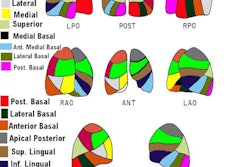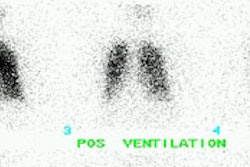Thrombus Imaging
In the blood, fibrinogen is converted into fibrin by the action of thrombin. Fibrin then spontaneously polymerizes into strands of fibrin that form the substance of the clot.
Small Peptides: AcuTect
In patients with a prior history of deep venous thrombosis, it can be very difficult to distinguish acute from old thrombus on conventional imaging modalities. Also- conventional modalities such as ultrasound are limited to the extremities when assessing for deep venous thrombosis.
AcuTect (Tc-99m-apcitide) is a synthetic peptide that binds to activated platelets [3]. AcuTect has a high affinity for the cell surface glycoprotein GPIIb/IIIa receptor which resides exclusively on activated platelets that are found only in acute clot. The GPIIb/IIIa receptor binds fibrinogen which promotes platelet aggregation. Because it is a small peptide, the agent is cleared rapidly from the bloodstream (less than 5% of the injected dose remains in the circulation 1 hour after injection) [4]. The agent undergoes primarily urinary excretion with about 75% of the administered dose eliminated during the first 8 hours. A small amount of the agent undergoes biliary excretion (between 10-30%) that results in bowel activity on later images [4]. Small peptides such as AcuTect may be immunogenic and can rarely be associated with a hypotensive response.
The exam is performed using 20 mCi of Tc-apcitide I.V. Good hydration and frequent voiding promote tracer clearance. Images are obtained of the lower extremities at 10, 60, and 120 minutes. Anterior and posterior static images are obtained from the pelvis to the feet (8 to 10 minutes per view, 128x128 matrix) for 750,000 counts over the pelvis and 500,000 counts of the lower extremities [3]. The exam is considered positive for acute DVT when an asymmetric linear focus of increased tracer uptake is detected along the course of a deep vein [3]. Thrombi can be visualized as early as 15 to 30 minutes after injection, but conspicuity generally improves overtime as blood-pool activity clears [4]. Activity that does not persist or is not apparent on the late image set is not indicative of DVT. The sensitivity of the exam for DVT detection is about 84-88% and specificity about 86-91% [3]. The agent has the ability to bind to thrombi, even when anticoagulation therapy has been instituted [4]. For the detection of DVT, planar imaging is adequate [4]. It is normal to see a faint "halo" of activity in the soft tissues about the knees. The agent can also accumulate in post-surgical sites.
Pulmonary embolism can also be detected, but requires SPECT imaging [4].
Radiolabeled platelets:
Radiolabeled platelets (In-111 platelets) demonstrate high uptake in fresh thrombi (less than 10 hours old). Drawbacks are: 1- The labeling procedure is cumbersome and time consuming (requiring up to 2 hours). 2- Imaging is usually delayed 6 to 24 hours and therefore does not provide timely clinical information. 3- The degree of platelet uptake is dependent on the age of the thrombus. Less activity is seen in older thrombi as they contain predominantly fibrin and entrapped red cells. 4- Small thrombi can be missed due to the relatively high background blood pool activity. 5- Heparin and warfarin can interfere with platelet uptake, however, positive images may be obtained if the anticoagulant drugs are discontinued at least 4 hours prior to injection of the tracer.
Antiplatelet Antibodies:
Antiplatelet antibodies also bind to forming, acute thrombi. Antibodies reactive with platelets are influenced by heparin and only detect actively forming fresh thrombi (less than 2 days old).
Small peptides with platelet affinity labeled with Tc-99m are also being evaluated. These small peptides with specific amino acid sequences are more advantageous than complex, large molecular weight antibodies since they can be produced synthetically, have faster blood clearance, do not elicit a HAMA response, and are less expensive.
Radiolabeled Fibrinogen:
Radiolabeled fibrinogen has a receptor which permits it to bind to platelets, but the agent can also bind to fresh thrombi by taking part in the coagulation pathway. Additionally, fibrinogen is not antigenic. Unfortunately, anticoagulant drugs interfere with its incorporation into fresh thrombi, its blood clearance is slow (requires 24 hour images), and it is relatively insensitive in the detection of pre-existing thrombi.
Antifibrin Antibodies:
Antifibrin monoclonal antibodies will bind specifically to fibrin in both fresh and older thrombi. Unfortunately, many of these agents are hampered by poor thrombus-to-blood activity ratios and also require delayed images (at 24 hours). Antibody fragments have a more rapid blood clearance, and might enhance thrombus-to-background ratios.
Antifibrin (T2G1s) Antibodies F(ab)'2:
Antifibrin antibodies are targeted against the seven amino acid terminus of the beta chain of fibrin, which is exposed when thrombin removes fibrinopeptides A and B from intact fibrinogen. Thus the antibody binds only to acute thrombus (the epitope for antifibrin [T2G1s] is expressed only on newly formed thrombus). Thus, antifibrin antibodies can accurately differentiate acute from chronic thrombus. Although heparin therapy has the potential to adversely alter the binding of the antibody, this finding has not been supported in clinical trials.
Antifibrin DD-3B6/22 Fab':
Tc-99m labeled antifibrin DD-3B6/22 Fab' monoclonal antibody fragments specifically target the DD domain on human cross-linked fibrin with high affinity. Cross-linked fibrin forms the underlying backbone of both venous and arterial thrombi and the DD epitope is unique to cross linked fibrin. The agent does not cross react with fibrinogen, fibrinogen degradation products, the fibrin monomer, or red blood cells. The DD cross link remains associated with the core of the fibrin clot until lysis is complete, thus the agent localizes to both fresh and older formed thrombus, to which platelets no longer aggregate. Because a Fab' fragment is used, images can be acquired between 2 to 4 hours after injection.
REFERENCES:
(1) J Nucl Med 1993; Knight LC. Scintigraphic methods for detecting vascular thrombus. 34(Suppl): 554-61.
(2) J Nucl Med 1994; Stratton JR, et al. Imaging arterial thrombosis: comparison of technetium-99m-labeled monoclonal antifibrin antibodies and indium-111-platelets. 35: 1731-37.
(3) Radiographics 2000; Blum JE, Handmaker H. Role of small-peptide radiopharmaceuticals in the evaluation of deep venous thrombosis. 20: 1187-1193
(4) J Nucl Med 1995; Muto P, et al. Detecting deep venous thrombosis with technetium-99m-labeled synthetic peptide P280. 36: 1384-91

